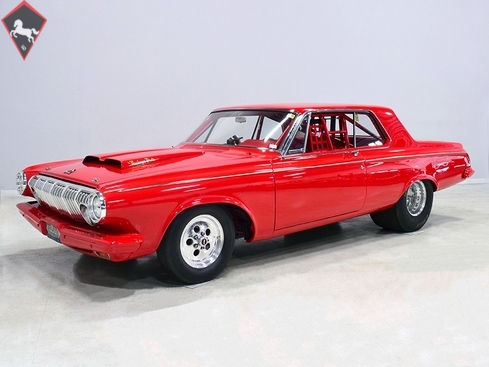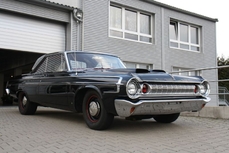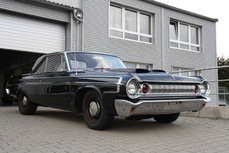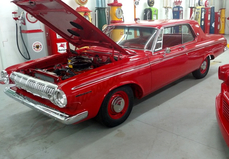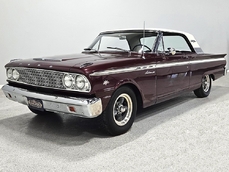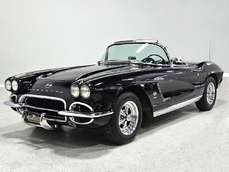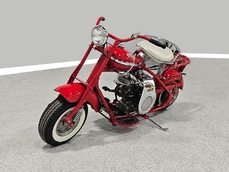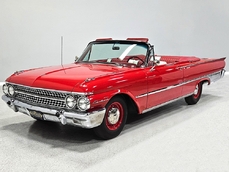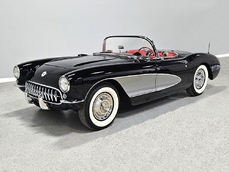Dodge Polara 426 cubic inch Max Wedge V8 1963
General description :
Chrysler seems to be the first company to figure out that factory-built performance cars were something the world needed. Before the early ‘60s, there were plenty of fast cars, but they were usually warmed-over production jobs. No, there were very few factory-built cars designed for speed first and foremost. Then some clever guys at Chrysler decided to take their biggest engine—a 413 cubic inch V8 from the biggest Imperials—and stuff it in a smaller, lighter car for the express purpose of generating speed. THAT was quick thinking. That 413 led to the 413 ‘Wedge’ which described the modified combustion chamber designed to make more power (along with a lot of compression, big valves, and a REALLY big cam). In 1963, they punched it out to 426 cubic inches, which not-so-coincidentally right next to the NHRA’s 427.2 cubic inch limit. Dual carbs on a cross-ram intake made these engines instantly identifiable and with GM stepping out of the racing game, the Mopars were dominant.
Which brings us to this stunning bright red 1963 Dodge Polara, which is one of those special Mopar performance vehicles packing the full-race 426 Max Wedge V8. It’s legit, with a copy of the build card to prove it (notable by the punch-out on the #9 under “Power Package”), and has a ton of period racing history to back it up. It’s one of a several such cars that were owned by a group of buddies here in Ohio, all carrying names like Buckeye Brute (this car), Buckeye Brawler, and the Buckeye Bandit, and they created decades’ worth of legends. There are surely guys who can tell the story in more detail than we can manage here, but the bottom line is that this car has lived the life these cars were supposed to live.
A few years ago, the vintage race car received a spectacular rotisserie restoration to its current condition—it’s quite a bit better than new in just about every way. Because it spent much of its life on the track, it shows just 32,560 original miles and it has never been wrecked or rusty so it’s still carrying all its original sheetmetal. Of course, some of that sheetmetal has been skillfully modified, including the quarters which now house some large-by-huge meats, but none of the changes jump out at you as radical (well, not in terms of the sheetmetal, anyway). During the restoration, all the various bumps and bruises that it might have suffered during its life on the track were expertly exorcised from the bodywork and it presents now as a show-quality car that’s simply stunning from any angle. It’s wearing PP1 Vermillion paint, just as it did in 1963, although there was never a factory paint job that glowed like this one. It remains all steel, including the hood wearing Super Stock scoops that force-feed the those two big Holley carbs underneath. The Polara styling in 1963 can’t quite be called beautiful, but it is certainly purposeful and I think I like that better—this is what we call an “industrial strength” Mopar. A simple strip of stainless side trim highlights the simple hardtop bodywork, along with bright window surrounds and the beautifully restored grille up front. Both front and rear bumpers have been painted to match, but the look works on this car and doesn’t stand out as non-authentic. And while this car wore graphics and sponsor decals almost its entire life, the only flash it carries today are “The Buckeye Brute” script on the hood scoop.
This Max Wedge Polara neatly straddles the street/race fence, bringing enough power to be competitive but with a full interior it’s reasonably comfortable as well. Of course, there’s a full NHRA-spec cage, which is as expertly fabricated as the rest of the car, but it also includes twin bucket seats, full carpets, reproduction door panels, and the factory dash and gauges, all restored. For race purposes, there’s also an Auto Meter Monster tach and shift light on top of the dash, a set of auxiliary gauges underneath, and a programmable delay box. Sadly, the factory pushbutton shifter for the TorqueFlite automatic is gone, replaced by a trick shifter on the floor that makes managing the manual valve body easy. Obviously the back seat is gone, but the tubs and interior panels are expertly upholstered to look almost OEM and there’s enough sound-deadening materials underneath to at least give the impression that this car was meant for the street. The trunk is equally well-finished and includes a 3-gallon racing fuel cell, fuel pump, and battery with shut-off switch, but it’s worth noting that a 16-gallon fuel cell is included with the car and it bolts right in with no modifications should you want to make this a street car.
For much of its racing life, this Polara carried a 383 cubic inch V8. That seems kind of anachronous in a car built for combat with a 426 cubic inch powerplant by the factory, but it meant that the original Max Wedge motor was never blown up. When restoration time came, it was rebuilt and dropped back between the fenders, just as it should be. And make no mistake, this isn’t some tame version of a ‘60s performance car, it’s NASTY. 13:1 compression, a seriously big cam, forged internals, electronic ignition, and those two big Demon double pumpers on top of the factory intake. This ain’t no cruise night special, although it was built with streetability in mind. It starts easily, idles reasonably well, and is properly dialed-in so it runs like, well, like a full-tilt race car should. Those gorgeous stainless headers wrap into the fenders and there is no exhaust system, so it sounds like the end of the world when it cackles to life—yeah, if you want this to be a street car, you’ll probably need to add an exhaust system. It’s beautifully detailed to replicate most of the factory look, including the bright orange engine enamel, reproduction “Super Stock II” valve cover decals, and even a proper 26-inch radiator up front, not some aluminum piece. Of course, it does have an electric water pump and fan, a big transmission cooler, and the various bits required if you’re going to put it safely on the track. It’s nevertheless impressive as hell to pull the pins and lift that hood.
The chassis was heavily fortified to work on the track, including a full back-half conversion and a mini frame connecting the front and rear subframes (remember the Polara was a unit-body car). The front suspension remains stock, including the torsion bars, and given how fast this sucker is, you’ll be glad to see disc brakes at all four corners. Steering is manual, but if your first worry is whether your wife can handle it, it’s probably not the right car for you. The 3-speed TorqueFlite automatic transmission features a high-stall torque converter and a reverse manual valve body (race car, remember), as well as a deeper pan and a blow-proof strap. Shockingly, the rockers are original and you can still see the factory spot welds running front to rear, and even most of the floors are untouched. The rear axle is a heavily modified and reinforced Dana 60 packed with 4.56 gears on a locker, custom axles, and hanging on a trick 5-link setup with adjustable coil-over shocks. Oh, and a set of wheelie bars, and I’m guessing you’ll be glad to have them sooner or later. And just so you don’t think this car is a poser, we left the rubber on the quarters and trunk floor. 15-inch Weld wheels are a traditional look and carry 28x7.50-15 Mickey Thompson rubber up front and 32x14.50-15 Goodyear meats at the business end.
Documentation is extensive, including period photos, Chrysler Corporation documentation and build card, a Max Wedge manual, restoration photos, and more.
This is a beautiful car that was a true labor of love by a guy who knew this car inside and out. It’s bloody fast, but it’s also shockingly detailed and exceptionally well finished. It isn’t quite 100% race and not quite ready for the street, but it has participated in multiple street events, including the Hot Rod Power Tour, so it’s usable enough. And nothing else can control a scene like this thing cackling and bucking and snarling its way into a show. If you’re familiar with the Max Wedge cars, you know this is a special chapter in Mopar performance history. Just an incredible piece at a price that’s a fraction of the cost of the restoration. Call today!
Harwood Motors always recommends and welcomes personal or professional inspections of any vehicle in our inventory prior to purchase.
http://www.harwoodmotors.com/vehicles/inventory_details.php?id=1243
1963 Dodge Polara 426 cubic inch Max Wedge V8 is listed sold on ClassicDigest in Macedonia by for $69900.
Car Facts
Car type : Car Make : Dodge Model : Polara Model Version : 426 cubic inch Max Wedge V8 Engine size : 0.0 Model Year : 1963 Location : Ohio
Sold
Seller Information
Sold
People who viewed this Dodge Polara also viewed similar Dodge listed at ClassicDigest
Other cars listed for sale by this dealer
About Dodge
Dodge Brothers Company, founded by Horace and John Dodge in 1900, initially produced components for car manufacturers. In 1914 they stepped into car manufacturing when introducing four-cylinder Dodge Model 30 with all-steel body and 12v electric system.By 1920 Dodge had become the second biggest car manufacturer in the USA, unfortunately the same year both of the brothers died, the company in turn to was sold to Chrysler Corporation in 1928. Dodge found a niche Chrysler Corporation lineup above low-priced Plymouth and medium-priced DeSoto, but somewhat below the top-of-the-line Chrysler
